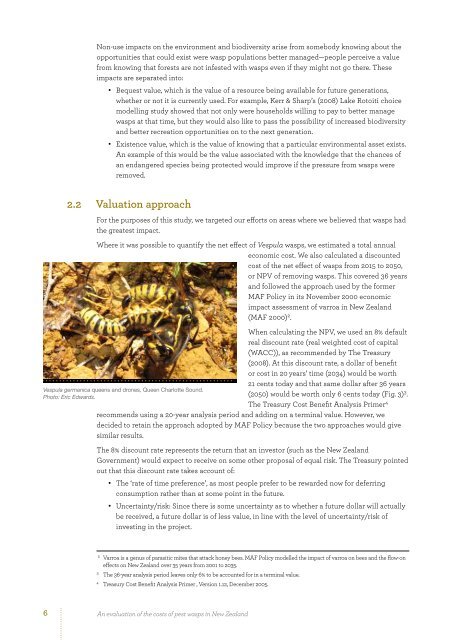evaluation-pest-wasps-nz
evaluation-pest-wasps-nz
evaluation-pest-wasps-nz
Create successful ePaper yourself
Turn your PDF publications into a flip-book with our unique Google optimized e-Paper software.
Non-use impacts on the environment and biodiversity arise from somebody knowing about theopportunities that could exist were wasp populations better managed—people perceive a valuefrom knowing that forests are not infested with <strong>wasps</strong> even if they might not go there. Theseimpacts are separated into:••Bequest value, which is the value of a resource being available for future generations,whether or not it is currently used. For example, Kerr & Sharp’s (2008) Lake Rotoiti choicemodelling study showed that not only were households willing to pay to better manage<strong>wasps</strong> at that time, but they would also like to pass the possibility of increased biodiversityand better recreation opportunities on to the next generation.••Existence value, which is the value of knowing that a particular environmental asset exists.An example of this would be the value associated with the knowledge that the chances ofan endangered species being protected would improve if the pressure from <strong>wasps</strong> wereremoved.2.2 Valuation approachFor the purposes of this study, we targeted our efforts on areas where we believed that <strong>wasps</strong> hadthe greatest impact.Where it was possible to quantify the net effect of Vespula <strong>wasps</strong>, we estimated a total annualeconomic cost. We also calculated a discountedcost of the net effect of <strong>wasps</strong> from 2015 to 2050,or NPV of removing <strong>wasps</strong>. This covered 36 yearsand followed the approach used by the formerMAF Policy in its November 2000 economicimpact assessment of varroa in New Zealand(MAF 2000) 2 .When calculating the NPV, we used an 8% defaultreal discount rate (real weighted cost of capital(WACC)), as recommended by The Treasury(2008). At this discount rate, a dollar of benefitor cost in 20 years’ time (2034) would be worth21 cents today and that same dollar after 36 years(2050) would be worth only 6 cents today (Fig. 3) 3 .The Treasury Cost Benefit Analysis Primer 4recommends using a 20-year analysis period and adding on a terminal value. However, wedecided to retain the approach adopted by MAF Policy because the two approaches would givesimilar results.Vespula germanica queens and drones, Queen Charlotte Sound.Photo: Eric Edwards.The 8% discount rate represents the return that an investor (such as the New ZealandGovernment) would expect to receive on some other proposal of equal risk. The Treasury pointedout that this discount rate takes account of:••The ‘rate of time preference’, as most people prefer to be rewarded now for deferringconsumption rather than at some point in the future.••Uncertainty/risk: Since there is some uncertainty as to whether a future dollar will actuallybe received, a future dollar is of less value, in line with the level of uncertainty/risk ofinvesting in the project.2Varroa is a genus of parasitic mites that attack honey bees. MAF Policy modelled the impact of varroa on bees and the flow-oneffects on New Zealand over 35 years from 2001 to 2035.3The 36-year analysis period leaves only 6% to be accounted for in a terminal value.4Treasury Cost Benefit Analysis Primer , Version 1.12, December 2005.6 An <strong>evaluation</strong> of the costs of <strong>pest</strong> <strong>wasps</strong> in New Zealand


